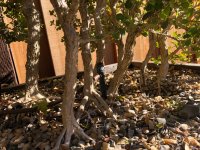Notsureaboutplantnames
Yamadori
I was gifted this boxwood grove last fall, just in time for the "normal" heat wave to hit Santa Cruz, and a week before heading to Europe for a vacation. My friend planted this grove in 2007 with Buxus japonica.

I love the cloud look but I would like to see more of the trunks. In doing that it might look like a pompom tree. I guess that makes me think I need to open up the canopy some "to let birds fly in".
The color is not great, heat last year and I think genetics during winter. There is also a family disagreement about too much sun

I think the roots are too exposed and could use a repot.
Any suggestions?

I love the cloud look but I would like to see more of the trunks. In doing that it might look like a pompom tree. I guess that makes me think I need to open up the canopy some "to let birds fly in".
The color is not great, heat last year and I think genetics during winter. There is also a family disagreement about too much sun

I think the roots are too exposed and could use a repot.
Any suggestions?





